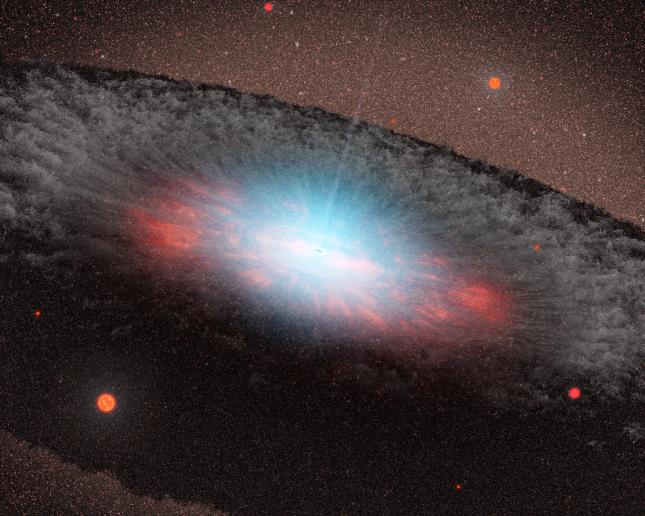Not too long ago, astronomers figured out that most large galaxies – including our own – have a supermassive black hole (an enormous object which can be billions of times the Sun’s mass) right in its core. Along with this astonishing finding, an unsettling question was raised: Which came first, galaxies or the supermassive black holes in their cores?

Artist’s concept of a supermassive black hole and its accretion disc at the centre of a galaxy. (Credit: NASA/JPL-Caltech)
The cosmic chicken-and-the-egg problem
Scientists know that there is an intrinsic relationship between the galaxy and its black hole. It’s believed that black holes and galaxies grow together, in a kind of partnership. As the black hole swallows the material in the surrounding area, it becomes more and more massive, and the more massive a black hole is, the more radiation it blasts out. This powerful radiation heats up the clouds of gas in the galaxy, but it’s still unclear whether this radiation boosts or prevents the formation of new stars.
By studying the nearby galaxies, astronomers also figured out that there is an elegant relation between the mass of the supermassive black holes and the giant cloud of stars and gas in the core of their galaxies (nicknamed “bulge”): no matter how big is the galaxy, the black hole is always about 700 times more massive than the bulge. Although this suggests that galaxies and their black holes evolve together, scientists weren’t sure whether this rule was obeyed in the early universe.
Looking back in time

This image, taken by the Very Large Array radio telescope, shows the gas clouds of a galaxy as it appeared just 870 million years after the Big Bang. It’s used to analyse the motion of the gases orbiting the ancient black hole hidden in core. (Credit: NRAO/AUI/NSF)
In order to see the first black holes, astronomers need to look as deep into space as possible. The problem is that it’s not easy to observe an ancient galaxies in details, mainly because of their high redshift. The most easily seen galaxies in higher redshifts are quasars, due to their extreme brightness. Nevertheless, separating the radiation emitted by the supermassive black hole from the glare of the quasar is a tough challenge.
To calculate the size of the Milky Way’s supermassive black hole – as we cannot actually “see” it, – astronomers needed to measure the speed of the stars orbiting in the heart of the galaxy: the faster the stars move around the black hole, the more massive it is. Measuring the size of a supermassive black hole hosted in another galaxy is an even more complex task: the scientists need to analyse the infrared light coming from the centre of the galaxy. Moreover, the data needs to be carefully filtered, in order to separate the radiation emitted by the black hole from the light coming from other objects in the galaxy.
Using powerful radio telescopes, such as the Very Large Array (VLA) in U.S. and the Atacama Large Millimeter/sub-millimeter Array (ALMA) in Chile, along with image-filtering processes, astronomers were finally able to get accurate measurements of the mass of these early black holes and had a big surprise.
In the galaxies observed during the studies, the black holes were only 30 times less massive than the bulge of their host galaxy, breaking the rule we see in the modern galaxies. It appears to solve the chicken-and-the-egg mystery, indicating that black holes actually came first.
Despite this major discovery, the origins of the supermassive black holes remains one of the most hotly debated topics in astronomy. Many undergoing projects are trying to pile up evidences to either underpin or contest this theory, and better explain when and how this mysterious relation came about.